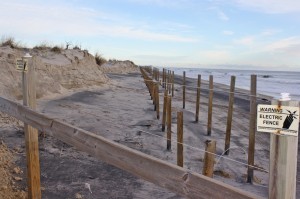
ASSATEAGUE — Assateague Island was slowly coming back to life, at least from a human standpoint, yesterday after Hurricane Sandy made her presence felt early this week, but the barrier island, like most coastal areas, took a good beating.
Two days after the last vestiges of Sandy cleared out of the area, the Assateague Island State Park reopened for visitors yesterday morning on a limited basis, while the Assateague Island National Seashore remained closed. The National Seashore was expected to open to the public on a limited basis by Friday morning.
The beaches at Assateague suffered considerable erosion with the front of the man-made and natural dune line sheared off on the ocean side leaving sand fences, railings and other structures completely erased or dangling from their supports in many cases. According to Assateague Island National Seashore spokesperson Rachelle Daigneault, the heavy surf breached the dune line in some spots and the ocean was still flowing behind the dunes into park areas during high tides.
“The island survived, as it always does, but there is considerable damage,” she said. “There is some good news and some bad news.”
The good news is, the barrier island has always been battered by storms and always rebounds when left to its natural processes. The island actually migrates several feet each year as storms and high tides wash sand from the ocean beaches and deposit it on the back side. Epic storms such as Sandy this week expedite the process, but the island will naturally recover over time.
“When allowed to just do its natural thing, the island actually rolls over itself,” said Daigneault. “Visitors will find a very different looking beach when they return, but it’s nothing to be alarmed about. The island generally repairs itself naturally.”
The protective dune along the state park area suffered considerable damage, but held up for the most part aside from a few breaches. However, while inspections and measurements were being taken yesterday morning, it remains uncertain if the dune system will need beach replenishment or nourishment. While the federal Army Corps of Engineers was in Ocean City this week inspecting damage to the replenished beach, it is unlikely any man-made help will be required for the dunes and beaches at Assateague.
“We don’t usually do that although we’ve had to in the past,” said Daigneault. “If we allow the natural processes to take place, it should replenish. There are definitely areas where the dunes did not hold out and there are still wash overs in some areas, but for the most part, they did their job. One of the reasons we are able to open the north end parking areas so quickly is because the dunes protected the man-made structures there.”
As Daigneault suggested, the beaches at Assateague certainly appear different than they did prior to Sandy, but there is no major reason for alarm. For example, the surface of the beach is covered in thick, black sand, but it is natural sand and not black as a result of oil or other pollution.
“The black sand is always under the surface and it’s usually covered with the lighter, white sand,” she said. “Much of the finer surface sand was swept away by the storm and deposited elsewhere.”
The beaches are littered with storm debris including battered sand fences, drift wood, what appears to be relics of former storms and shipwrecks, conch shells as far as the eye can see and most noticeably, old tires. In the 1970s, thousands of old tires were banded together to create an artificial reef off the coast, which seemed at the time to be a good idea, but the reef has broken apart over the decades and the tires are deposited on the beach after most major storms including Sandy this week. In 2009, after Tropical Storm Ida hit the area, over 2,000 old tires were collected from the Assateague beaches.
Assateague’s most famous residents, the herd of wild ponies, weathered the storm relatively unscathed, as did the native deer population and other wildlife. The famous ponies, which number over 100, are wild animals and are adjusted to the often harsh life on the barrier island.
“We don’t know the status of the entire herd and that will take some time, but we have seen quite a few of them and they are not the worse for wear,” said Daigneault. “So far, the ones we’ve seen are going about their business like nothing happened. We’ve also seen a lot of deer and tree swallows. The wildlife was teeming on the island right after the storm.”
While state and federal parks officials are still taking inventory of many of the man-made structures on Assateague, most appear to have held up. A naturalist station was lifted off of its pilings and deposited a short distance away. The South Ocean Beach parking and camping areas are still inundated with sand, while the north end of the state park is open for business.
The Verrazano Bridge was inspected and was open for vehicle traffic almost right after the storm. However, the parallel pedestrian and bicycle bridge remains closed and will be indefinitely. The foot path on the island side of the pedestrian bridge was eroded to the point it is not safe to pass.
